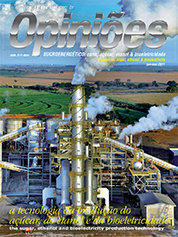Cláudio Mariano Vaz
Director of Engenho Novo Tecnologia
Op-AA-27
Water X effluent
Albeit all efforts currently undertaken, the sugar and ethanol industry is still stigmatized as a major pollutant and water consumer. To a large extent, this is due to the intrinsic features of the raw material (large quantities of impurities and water contained in sugarcane) and its process (high need for refrigeration thermal exchanges).
In view of these natural disadvantages and growing environmental requirements, the industry must accelerate investments in the development and adaptation of conservation technologies that are specifically tuned to its characteristics, so as to thereby remain in synchronization with all other industries.
Rationalizing water consumption must necessarily take into consideration technical and economic aspects relative to the treatment of the resulting liquid effluent, thereby setting the hydric balance of the industry (entries and subtractions). The feasibility of available alternatives greatly depends on this balance.
In the quest for more appropriate solutions, one should bear in mind that the reduction of new water consumption allows reducing not only the cost of collecting water, but also a reduction in the necessary costs to streamline the effluent outflow – by reducing the volume, the treatment capacity is reduced. In this search, three main methods should be considered:
1. reduction of water waste, considering the current process;
2. reduction in water consumption by making changes to the process;
3. treatment and reutilization of treated effluent.
Of the three methods, the first is economically the best, offering immediate results, and should therefore be given priority. In opposition to its implementation, however, there is the cultural and natural resistance of human beings, requiring major efforts in bringing about awareness. In general, the second method has a high cost, and hence, its feasibility depends on special opportunities, such as additional savings resulting directly from the reduction in water consumption.
In addition, given that it results in alterations to the process, this method may interfere in all the other production phases and requires complex adaptations. For example, the dry cleaning of sugarcane introduced considerable volumes of earth and sand into the process, adversely affecting from the treatment of the juice to the treatment of water to wash the gases from the boilers (end of the line).
In the third method, one must consider an additional treatment phase, to match the volume of effluent to be reutilized with the quality standard required for such reutilization. Whereas the previous two methods reduce the volume of new water that flows into the facility, and hence, the volume of effluent generated, the third method’s reutilization even allows the use of a large water flow in a closed circuit (highly convenient for some of the process phases).
To exemplify: the new Boiler Gas Washing Water Treatment Stations (for soot) allow to continuously recycle more than 1 million liters/hour, while replacing only 2 to 5% of the water lost in smoke and discharged solids. The introduction of this technology allowed the industry significant reductions in water consumption and environmental pollution (in the bagasse boilers, 5 to 10 kg of dry material/ton of vapor generated are produced, which were previously launched to the atmosphere or flowed into rivers).
To streamline studies on how to rationalize the balance of water and effluent, some overall considerations should be made:
1. to facilitate its treatment and reutilization, effluent needs to be classified according to type and grade of contamination, separating oily water, sugar water, soot water and refrigeration water. For example: oily water makes biological treatment processes significantly more difficult, whereas it can easily be treated by flotation, also allowing for its reutilization. Furthermore, residual sugar in gas washing water can result in the reduction of the PH level and fermentation in the medium, with the generation of effluent incompatible with the soot decanting process.
2. the required degree of treatment for effluent reutilization in its own original application is in general smaller than that required for its discharge, thereby reducing the total treatment cost.
3. sugar containing effluent in general relates to large outflows with low sugar concentrations, which are incompatible conditions vis-à-vis modern and compact biological treatment techniques. In addition, the biological phase must be preceded by treatment to remove solids (also necessary to prevent siltation).
An interesting alternative to this scenario consists of clarifying and reutilizing a part of the sugar effluent for washing in general, with the resulting reduction in the final volume to be discharged and the increase in the concentration of residual sugar, making it more compatible with the subsequent biological phase.
Adjusting the sugar, ethanol and bioelectricity industry to environmental norms requires the reassessment of production concepts in light of new technologies available in the market for treatment and reutilization of effluent. Production expansion projects and the implementation of new industrial units are excellent opportunities to tune the industry to more modern concepts as applied to industry-environment integration.




